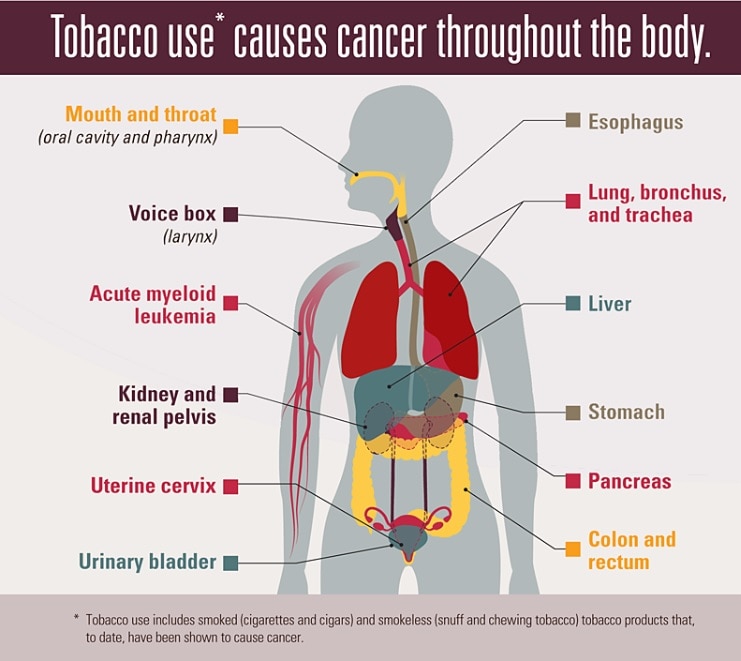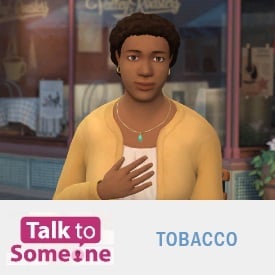Tobacco and Cancer
Tobacco use can cause cancer almost anywhere in your body.
Note: This page refers to commercial tobacco products that are made and sold by tobacco companies. It does not include traditional tobacco used by Indigenous groups for religious or ceremonial purposes.
If you were asked to describe the relationship between tobacco and cancer, you might think of lung cancer. It’s true that smoking tobacco products (including cigarettes and cigars) causes almost nine of every 10 cases of lung cancer. But tobacco use can cause cancer almost anywhere in your body, including in the—
- Bladder.
- Blood (acute myeloid leukemia).
- Cervix.
- Colon and rectum.
- Esophagus.
- Kidney and renal pelvis.
- Liver.
- Lungs, bronchi, and trachea.
- Mouth and throat.
- Pancreas.
- Stomach.
- Voice box (larynx).
Health Advice for People Who Use Tobacco or Are Thinking of Using Tobacco
“We did it. You can, too!” Three former smokers share tips that helped them quit in this video. For more help quitting, visit smokefree.gov.
The most important things you can do to avoid health risks from cancer are—
- If you don’t use tobacco—don’t start!
- If you do use tobacco—quit!
No matter how long you have used tobacco, quitting can reduce your risk for cancer and other chronic diseases. Many people who use tobacco become addicted to nicotine, a drug found naturally in tobacco. This makes it hard to quit using tobacco. Most people who use tobacco try to quit several times before they succeed. There are proven steps that can help you quit. For more information about quitting tobacco use, go to smokefree.gov.
How Tobacco Products Cause Cancer
Tobacco Smoke
Smoke from cigarettes, cigars, and pipes has at least 70 chemicals that can cause cancer. Every time you breathe in that smoke, those chemicals get into your bloodstream, which carries the chemicals to all parts of your body. Many of these chemicals can damage your DNA, which controls how your body makes new cells and directs each kind of cell to do what it is made for. Damaged DNA can make cells grow differently from how they are supposed to. These unusual cells can turn into cancer.
Secondhand Smoke
People who smoke are not the only people who can get cancer from tobacco smoke. People around them—their kids, partners, friends, coworkers, and others—breathe in that smoke, too, called secondhand smoke.
Smokeless Tobacco Products
Smokeless tobacco products, such as dipping and chewing tobacco, can cause cancer, too, including cancers of the esophagus, mouth and throat, and pancreas.
Electronic Cigarettes
Electronic cigarettes make a mist (often called a cloud) by heating a liquid that contains flavorings and chemicals, many of which are harmful. The liquid usually contains nicotine, the addictive drug in cigarettes and other tobacco products. Users inhale the mist into their lungs. People nearby can also breathe in this mist. E-cigarettes are not safe for youth, young adults, pregnant women, or adults who don’t use tobacco products.
Health Disparities
Differences between groups of people in their level of health, quality of health care, and how many have a particular health problem are called health disparities. The groups of people might differ by age, race, income, rural residence, or some other characteristic. Learn about tobacco-related disparities.
Resources to Help You Quit

